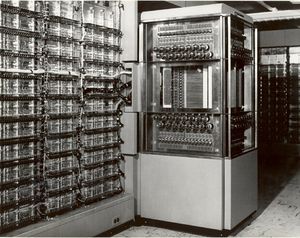Magnetic-Core Memory

This article was initially published in Today's Engineer on August 2003
On 8 August 1953, engineers installed a component that resembled a chain link fence on the Whirlwind computer, a joint project between the Massachusetts Institute of Technology (MIT) and the U.S. Navy. The project, led by MIT’s Jay W. Forrester and built by engineer William Papian, entailed a real-time interactive simulator and stabilizer analyzer for Navy flight training. The component was the first magnetic-core memory and helped the Whirlwind compute at an impressive speed. This month marks the 50th anniversary of this momentous event, which changed computer history.
Why was the magnetic-core memory so significant? An IEEE Milestone nomination underscores the reason. IEEE’s Santa Clara Valley Section and the Magnetic Disk Heritage Center gained recognition for the site where RAMAC, the first magnetic disk drive, was produced between 1952 and 1958. The RAMAC’s contributions are similar to innovations fostered by magnetic-core memory: real-time processing. RAMAC magnetic disk drives allowed computers to move toward processing in real time by incorporating magnetic random-access storage. The Sabre Airline Reservation System of 1960, the first truly real-time, online, computing transaction system, represents RAMAC’s first successful application.
Forrester’s earlier magnetic-core memory benefited RAMAC’s disk drive. The magnetic-core, a wire mesh of ferrite rings and metal wire, created a location where binary information could be recorded and retrieved magnetically. The ability to pinpoint specific intersections or addresses within the core rings, from which information could be stored and then recalled at random, created an unparalleled innovation. The computer’s central processing unit and its memory of stored data, procedures and programs, could now be operated interactively. This interactivity was based on one major innovative gain: speed. Random-access memory, RAM, was born.
Although increased computing speed was always a goal, it was not feasible in the early systems that relied on tape drives for memory access. Magnetic-core memory changed this technological bottleneck. When Forrester began working on the Navy’s flight simulator system in 1945, he quickly realized that the system needed a computer that could respond to a pilot's actions. The system required real-time reaction and lightening-speed access to binary bits of stored memory. The Whirlwind computer became the first digital computer with a magnetic-core memory that could operate in real, interactive time.
Whirlwind was first demonstrated on 20 April 1951, and the core memory was installed in August of 1953. Whirlwind’s triumph underwrote the growth of the MIT Lincoln Labs, the [[MITRE_Corporation|MITRE corporation][ and the SAGE (Semi-Automatic Ground Environment) air defense system, which operated in the United States until the Air Force ended the program in 1983.
Magnetic-core memory’s popularity lasted until integrated circuitry superseded it in the 1970s. But the greatest legacy that Whirlwind, Forrester, and magnetic-core memory left lies in the conceptualization of random-access memory and the instantaneous speed of real-time processing. Where would we be today if we could not withdraw money from an ATM, buy gas, or have our checking accounts updated in real time? Or make a hotel or plane reservation? Or sit down with our laptops and work online while our personal computers encompass storage, memory, real time and networking all in one immediately gratifying package? Magnetic-core memory spawned the birth of the random-access era; its anniversary is one worth noting.
Limits
The capacity and speed of magnetic storage devices continue to improve, mainly by increasing areal density by decreasing the storage spot size. Increasing storage densities require reduced size of read/write heads, increases in sensitivities, close alignment of the head-to-disc distances and improved materials. The highest density magnetic storage demonstrated is 1 Tb per square inch, in March 2012 by Seagate Technologies, using heat-assisted magnetic recording to achieve this result.